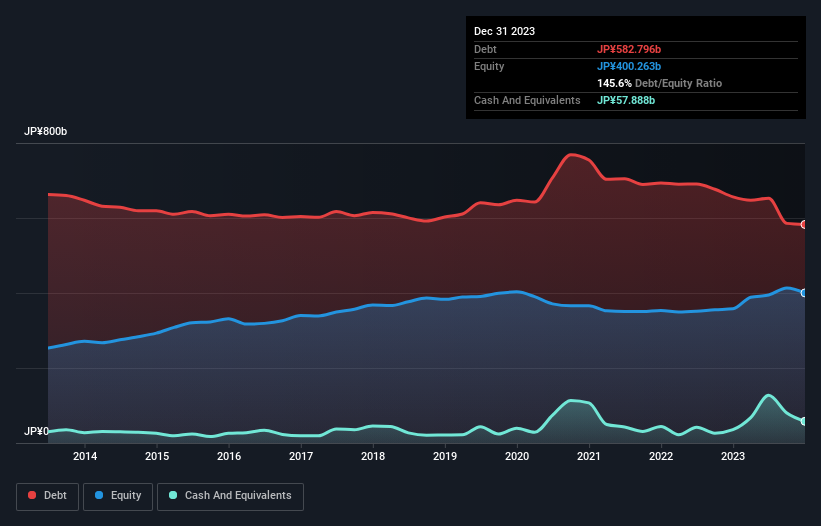
David Iben put it well when he said, 'Volatility is not a risk we care about. What we care about is avoiding the permanent loss of capital.' So it seems the smart money knows that debt - which is usually involved in bankruptcies - is a very important factor, when you assess how risky a company is. We note that Odakyu Electric Railway Co., Ltd. (TSE:9007) does have debt on its balance sheet. But should shareholders be worried about its use of debt?
What Risk Does Debt Bring?
Debt is a tool to help businesses grow, but if a business is incapable of paying off its lenders, then it exists at their mercy. Part and parcel of capitalism is the process of 'creative destruction' where failed businesses are mercilessly liquidated by their bankers. However, a more usual (but still expensive) situation is where a company must dilute shareholders at a cheap share price simply to get debt under control. By replacing dilution, though, debt can be an extremely good tool for businesses that need capital to invest in growth at high rates of return. The first step when considering a company's debt levels is to consider its cash and debt together.
View our latest analysis for Odakyu Electric Railway
What Is Odakyu Electric Railway's Net Debt?
The image below, which you can click on for greater detail, shows that Odakyu Electric Railway had debt of JP¥582.8b at the end of December 2023, a reduction from JP¥656.5b over a year. However, it also had JP¥57.9b in cash, and so its net debt is JP¥524.9b.

A Look At Odakyu Electric Railway's Liabilities
Zooming in on the latest balance sheet data, we can see that Odakyu Electric Railway had liabilities of JP¥428.7b due within 12 months and liabilities of JP¥447.5b due beyond that. Offsetting this, it had JP¥57.9b in cash and JP¥23.6b in receivables that were due within 12 months. So its liabilities outweigh the sum of its cash and (near-term) receivables by JP¥794.7b.
Given this deficit is actually higher than the company's market capitalization of JP¥687.2b, we think shareholders really should watch Odakyu Electric Railway's debt levels, like a parent watching their child ride a bike for the first time. Hypothetically, extremely heavy dilution would be required if the company were forced to pay down its liabilities by raising capital at the current share price.
We measure a company's debt load relative to its earnings power by looking at its net debt divided by its earnings before interest, tax, depreciation, and amortization (EBITDA) and by calculating how easily its earnings before interest and tax (EBIT) cover its interest expense (interest cover). The advantage of this approach is that we take into account both the absolute quantum of debt (with net debt to EBITDA) and the actual interest expenses associated with that debt (with its interest cover ratio).
As it happens Odakyu Electric Railway has a fairly concerning net debt to EBITDA ratio of 5.8 but very strong interest coverage of 14.0. So either it has access to very cheap long term debt or that interest expense is going to grow! Notably, Odakyu Electric Railway's EBIT launched higher than Elon Musk, gaining a whopping 107% on last year. The balance sheet is clearly the area to focus on when you are analysing debt. But ultimately the future profitability of the business will decide if Odakyu Electric Railway can strengthen its balance sheet over time. So if you want to see what the professionals think, you might find this free report on analyst profit forecasts to be interesting.
Finally, a company can only pay off debt with cold hard cash, not accounting profits. So the logical step is to look at the proportion of that EBIT that is matched by actual free cash flow. In the last three years, Odakyu Electric Railway basically broke even on a free cash flow basis. While many companies do operate at break-even, we prefer see substantial free cash flow, especially if a it already has dead.
Our View
We feel some trepidation about Odakyu Electric Railway's difficulty net debt to EBITDA, but we've got positives to focus on, too. For example, its interest cover and EBIT growth rate give us some confidence in its ability to manage its debt. Taking the abovementioned factors together we do think Odakyu Electric Railway's debt poses some risks to the business. So while that leverage does boost returns on equity, we wouldn't really want to see it increase from here. When analysing debt levels, the balance sheet is the obvious place to start. But ultimately, every company can contain risks that exist outside of the balance sheet. We've identified 3 warning signs with Odakyu Electric Railway (at least 2 which don't sit too well with us) , and understanding them should be part of your investment process.
When all is said and done, sometimes its easier to focus on companies that don't even need debt. Readers can access a list of growth stocks with zero net debt 100% free, right now.
New: AI Stock Screener & Alerts
Our new AI Stock Screener scans the market every day to uncover opportunities.
• Dividend Powerhouses (3%+ Yield)
• Undervalued Small Caps with Insider Buying
• High growth Tech and AI Companies
Or build your own from over 50 metrics.
Have feedback on this article? Concerned about the content? Get in touch with us directly. Alternatively, email editorial-team (at) simplywallst.com.
This article by Simply Wall St is general in nature. We provide commentary based on historical data and analyst forecasts only using an unbiased methodology and our articles are not intended to be financial advice. It does not constitute a recommendation to buy or sell any stock, and does not take account of your objectives, or your financial situation. We aim to bring you long-term focused analysis driven by fundamental data. Note that our analysis may not factor in the latest price-sensitive company announcements or qualitative material. Simply Wall St has no position in any stocks mentioned.
About TSE:9007
Odakyu Electric Railway
Engages in the transportation, real estate, merchandising, and other businesses in Japan.
Slight and fair value.
Market Insights
Community Narratives



